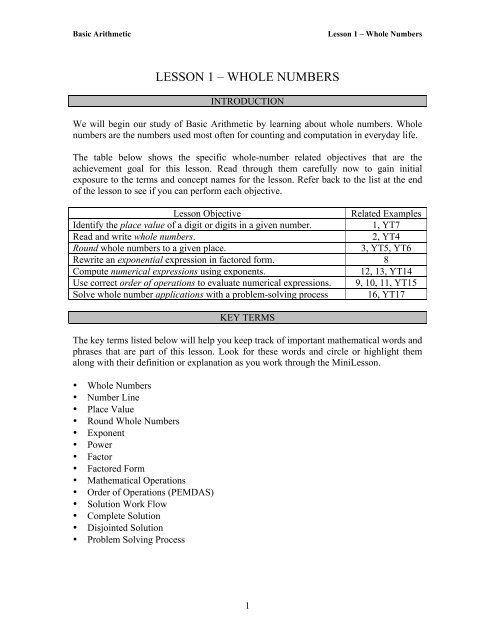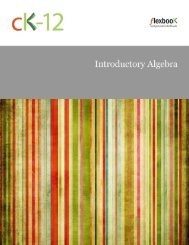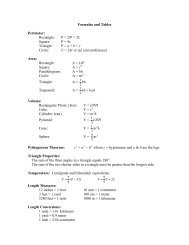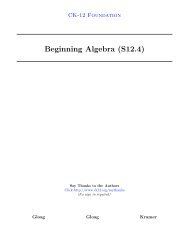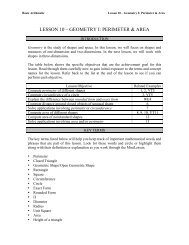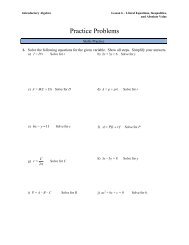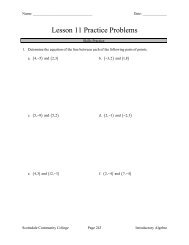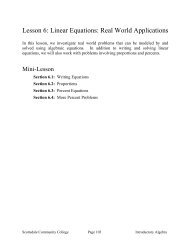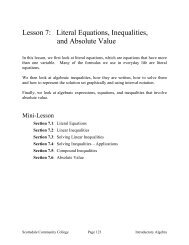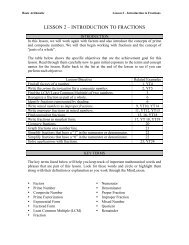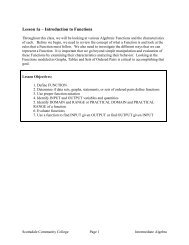LESSON 1 – WHOLE NUMBERS
LESSON 1 – WHOLE NUMBERS
LESSON 1 – WHOLE NUMBERS
You also want an ePaper? Increase the reach of your titles
YUMPU automatically turns print PDFs into web optimized ePapers that Google loves.
ContentsIntroduction......................................................................................................................................1 Agenda .............................................................................................................................................3 Panel Members.................................................................................................................................9 Speakers .........................................................................................................................................11 Planning Committee.......................................................................................................................13 Abstracts ........................................................................................................................................17 Background and Overview Gary A. Giovino, Ph.D., M.S.......................................................................................................19I. What Are the Effective Population- and Community-Based Interventions To PreventTobacco Use in Adolescents and Young Adults, Including Among Diverse Populations?Cultural Approaches to Community and School-Based Tobacco Prevention for Adolescentsand Young Adults, Including Priority PopulationsLourdes Baezconde-Garbanati, Ph.D., M.P.H. .........................................................................29Programs and Policies for PreventionJohn P. Pierce, Ph.D. ...................................................................................................................37Policy Interventions and SurveillanceJean Forster, Ph.D., M.P.H.........................................................................................................43II. What Are the Effective Strategies for Increasing Consumer Demand for and Use ofProven Individually Oriented Cessation Treatments, Including Among DiversePopulations?Increasing Consumer Demand for Effective Tobacco Cessation Treatments:The Promise for Breakthrough InnovationC. Tracy Orleans, Ph.D. ..............................................................................................................49 Increasing Demand for and Use of Cessation Treatments AmongLow-Income and Blue-Collar PopulationsElizabeth M. Barbeau, Sc.D., M.P.H..........................................................................................53Evidence-Based Practice Center Presentation: Increasing Demand for and Use of EffectiveTobacco Cessation Treatments Among IndividualsCathy L. Melvin, Ph.D., M.P.H...................................................................................................59iii
Basic ArithmeticLesson 1 <strong>–</strong> Whole NumbersTo round a number means to approximate that number by replacing it with anothernumber that is “close” in value. Rounding is often used when estimating. For example, ifI wanted to add 41 and 37, I could round each number to the nearest ten (40 and 40) thenadd to estimate the sum at 80.When rounding, the analogy of a road may help you decide which number you are closerto. See the image below. The numbers 43, 45, and 46 are all rounded to the nearest tensplace. Note that a number in the middle of the “road” is rounded up.Example 3:a. Round 40,963 to the nearest tens place.b. Round 40,963 to the nearest hundreds place.c. Round 40,963 to the nearest thousandd. Round 40,963 to the nearest ten thousandYOU TRY4. Write the number 12,304,652 using words.____________________________________________________________________5. Round 12,304,652 to the nearest million. ______________________________6. Round 12,304,652 to the nearest hundred. _______________________________7. What place does the digit 3 occupy in the number 12,304,652? _________________4
Basic ArithmeticLesson 1 <strong>–</strong> Whole NumbersEXPONENTSExponents are also called powers and indicate repeated multiplication.Worked Example 8: 3 4 = 3!3!3!3 = 9!3!3 = 27!3 = 81Note: There are 4 factors of 3 in the exponential expression 3 4 . When we write3 4 = 3!3!3!3, we have written 3 4 in factored form.On your calculator, you can compute exponents a couple of ways as follows:a) If you are raising a number to the second power (for example 4 2 ), look foran x 2 key on your calculator. Then, enter 4x 2 = or ENTER and you shouldget 16.b) If you are raising a number to a power other than 2, look for a carrot key (^).For example 4 5 = 4^5= and you should get 1024. Note that you can also usethe (^) key even when raising to the 2 nd power (also called “squaring”).ORDER of OPERATIONSAddition, subtraction, multiplication, and division are called mathematical operations.When presented with more than one of these in an expression, we need to know whichone to address first. The chart below will help us.P Simplify items inside Parenthesis ( ), brackets [ ] or other grouping symbols first.E Simplify items that are raised to powers (Exponents)M Perform Multiplication and Division nextDAS(as they appear from Left to Right)Perform Addition and Subtraction on what is left.(as they appear from Left to Right)Example 9: Evaluate 8 + 5 2Example 10: Evaluate 24 ÷ (4 + 2)Example 11: Evaluate 20 <strong>–</strong> (8 <strong>–</strong> 2) ÷ 3 42 10 − 4Example 12: Evaluate 10⋅ 3 +2Example 13: Evaluate2⎛⎛8+2⎞⎞⎜⎜ ⎟⎟⎝⎝7−2⎠⎠5
Basic ArithmeticLesson 1 <strong>–</strong> Whole NumbersWORK FLOW AND WRITING SOLUTIONSWhen you begin to do work that requires more than a single computation, the steps thatyou present in your solution should be equivalent. Try to provide a complete solution asseen in the videos as opposed to a series of disjointed computations. See the examplesbelow.COMPLETE SOLUTION <strong>–</strong> shows all work in neat, coherent, equivalent stepsDISJOINTED SOLUTION <strong>–</strong> shows work but steps are not equivalent, information is leftout of the solution processMATHEMATICS AND WRITINGWhen faced with a mathematical problem, you really have two goals. The first is to workthe problem correctly and the second is to present a complete solution that can be readand understood by yourself and by others. Just because you know how to do a problemtoday does not mean that you will quickly remember how to do it when you look back onit in the future. Strive to present complete solutions following the examples andpresentations that you see in the media links. Mathematics is really learned throughwriting. The better your solutions the more you will learn and retain. As you moveforward in mathematics, learning to write a good solution may help you solve problemsyou would not have been able to otherwise.6
Basic ArithmeticLesson 1 <strong>–</strong> Whole NumbersYOU TRY14. Evaluate by hand, showing all possible steps. Try to use good solution flow asdiscussed on the previous page.22+ 4× 8 − (2+3)Insert check mark to verify same result via calculator: __________15. Evaluate by hand, showing all possible steps. Try to use good solution flow asdiscussed on the previous page.9+ 3×75×2Insert check mark to verify same result via calculator: __________7
Basic ArithmeticLesson 1 <strong>–</strong> Whole NumbersAPPLICATIONS WITH <strong>WHOLE</strong> <strong>NUMBERS</strong>“Applications” ask you to use math to solve real-world problems. To solve theseproblems effectively, begin by identifying the information provided in the problem(GIVEN) and determine what end result you are looking for (GOAL). The GIVENshould help you write mathematics that will lead you to your GOAL. Once you have aresult, CHECK that result for accuracy then present your final answer in a COMPLETESENTENCEEven if the math seems easy to you in this application, practice writing all the steps, asthe process will help you with more difficult problems.Example 16: Amy drives to Costco to buy supplies for an upcoming event. She isresponsible for providing breakfast to a large group of Boy Scouts the next weekend.Hashed browns are on her list of supplies to purchase and she needs to buy enough toserve 100 people. The hashed browns are sold in packs of 8 boxes and each box in thepack will serve 4 people. A) How many packs should she buy minimum and B) Howmany people will she be able to serve with this purchase?GIVEN: [Write down the information that is provided in the problem. Diagrams can behelpful as well.]GOAL: [Write down what it is you are asked to find. This helps focus your efforts.]MATH WORK: [Show your math work to set up and solve the problem.]CHECK: [Is your answer reasonable? Does it seem to fit the problem? A check may notalways be appropriate mathematically but you should always look to see if your resultmakes sense in terms of the goal.]FINAL RESULT AS A COMPLETE SENTENCE: [Address the GOAL using acomplete sentence.]8


